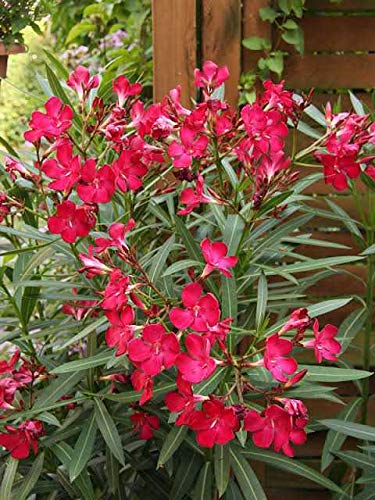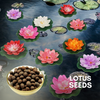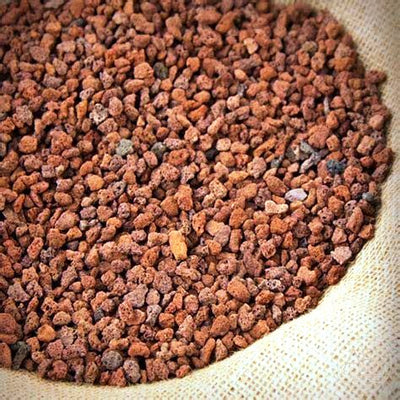

Red Oleander Live Plant- Green Paradise Live
Guaranteed Safe Checkout
Green Paradise Offers Beautiful Red Oleander Plant
About Red Oleander Plant
The Red Oleander plant, also known as Nerium oleander, is a popular flowering shrub that is native to the Mediterranean region. It belongs to the family Apocynaceae and is known for its striking beauty and vibrant red flowers.
Here's some information about the Red Oleander plant:
Appearance:
The Red Oleander is an evergreen shrub that can reach a height of 6 to 18 feet (1.8 to 5.5 meters). It has dark green, leathery leaves that are arranged in whorls along the stems. The plant produces clusters of showy, funnel-shaped flowers with five petals. While the name suggests "red," the flowers can also be found in shades of pink, white, and yellow, depending on the cultivar.
Toxicity:
It's important to note that all parts of the Red Oleander plant, including the leaves, stems, and flowers, contain toxic compounds called cardiac glycosides. These composites can be dangerous if ingested or indeed if the tire comes into contact with the skin. Therefore, caution should be exercised when handling the plant, and it is advised to keep it away from children and pets.
Cultivation:
Red Oleander is a popular ornamental plant in warm climates, particularly in subtropical and tropical regions. It thrives in full sun and well-drained soil. The plant is highly drought-tolerant and can withstand high temperatures. It can be propagated through seeds or stem cuttings.
Landscaping and Uses:
Due to its attractive flowers and glossy foliage, the Red Oleander is often used in landscaping to add color and beauty to gardens, parks, and residential areas. It can be grown as a hedge, specimen plant, or potted plant. The plant's ability to tolerate salt makes it suitable for coastal gardens. However, its toxic nature should be taken into consideration when choosing its placement.
Medicinal Uses:
Despite its toxicity, certain compounds found in the Red Oleander plant have been used in traditional medicine for various purposes. However, it's essential to note that the medicinal use of the plant requires expert knowledge, as improper usage can be life-threatening.
Symbolism:
In some cultures, the Red Oleander is associated with symbolism. It is often considered a symbol of beauty, love, and seduction. However, it's important to recognize the plant's toxic nature and not confuse its symbolic significance with its actual safety.
It's worth mentioning that if you are considering growing or handling Red Oleander, it's essential to do thorough research and exercise caution due to its toxicity. Consulting with a local horticulturist or gardening expert can provide you with more specific guidance and advice tailored to your region.
How To Grow Red Oleander Plant
Growing a red oleander plant can be an enjoyable and rewarding experience. However, it's important to note that oleanders contain toxins and can be harmful if ingested, so take necessary precautions.
Here's a general guide on how to grow a red oleander plant:
Choose a suitable location:
Red oleanders thrive in full sunlight, so select a spot in your garden that receives at least 6-8 hours of direct sunlight per day. Ensure the area has well-drained soil.
Prepare the soil:
Oleanders can tolerate a range of soil types, but they prefer slightly acidic to neutral soil (pH 6.0-7.5). If your soil is heavy or clay-like, consider adding organic matter like compost to improve drainage and fertility.
Planting:
Dig a hole that is about twice the size of the root ball of your red oleander plant. Place the plant in the hole, making sure it sits at the same depth it was previously growing. Backfill the hole with soil and gently tamp it down around the base of the plant.
Watering:
After planting, water the red oleander thoroughly to settle the soil. Thereafter, water the plant deeply once or twice a week, allowing the top inch of soil to dry out between waterings. Avoid overwatering, as oleanders can be susceptible to root rot.
Mulching:
Apply a layer of organic mulch around the base of the plant to help retain soil moisture, suppress weeds, and moderate soil temperature. Maintain a gap between the mulch and the stem to prevent rot.
Fertilization:
Red oleanders are relatively low-maintenance plants and don't require heavy fertilization. However, you can feed them with a slow-release, balanced fertilizer in spring and summer to promote healthy growth. Application rates should be used as directed by the manufacturer.
Pruning:
Prune your red oleander plant in late winter or early spring to maintain its shape, remove dead or damaged branches, and encourage new growth. Always wear gloves and protective clothing when handling oleanders, as their sap can cause skin irritation.
Pest and disease control:
Oleanders are generally resistant to pests and diseases. However, keep an eye out for common issues like aphids, scale insects, or spider mites. Treat any infestations promptly using organic insecticidal soap or horticultural oils.
Winter protection:
Red oleanders are hardy in USDA zones 8-11, but in colder climates, they may require winter protection. Consider growing them in containers that can be moved indoors during frosty periods or cover the plants with frost blankets.
Safety precautions:
As mentioned earlier, oleanders contain toxic compounds. Take precautions to ensure children and pets can't access the plant. If pruning or handling the plant, wear protective clothing, gloves, and eyewear, and wash your hands thoroughly afterward.
Remember to research specific information about the red oleander variety you have, as there can be slight variations in care requirements. Enjoy the vibrant blooms of your red oleander plant while appreciating it from a safe distance. nice and advice tailored to your region.


















